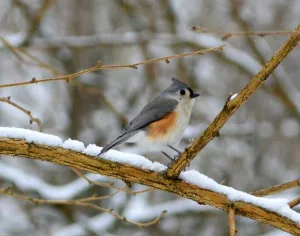
Through the cold months of winter, the animals that remain active in our woods, meadows, and neighborhoods are those with high rates of metabolism that sustain warm body temperatures—the endothermic (“warm-blooded”) birds and mammals. While some small mammals, like mice and shrews, are busy under the snow, those that are out and about this time of year are in the larger size range, from squirrels to raccoons, foxes, and deer. In contrast, winter-active birds—mostly from the group of perching birds called passerines–are, by and large, small. Carolina chickadees weigh in at about 12 grams, barely more than two teaspoons of water. Dark-eyed juncos (18 g), white-breasted nuthatches (20 g), and tufted titmice (20 – 25 g) are not much larger. Even the “big” species like cardinals (45 g), robins (75 g), and blue jays (100 g) are just 10 – 25% the size of a gray squirrel. How do these small birds manage to stay warm, even on days when most of us choose to remain comfortably indoors?
The underlying problem is that endotherms stay warm using their metabolism, burning fuels like sugar and fat to liberate energy. That energy ultimately is lost as heat, and in endotherms the metabolism proceeds at a high enough rate to warm the body. Heat loss is driven by the temperature difference between the body and the environment, and so heat escapes more readily during the cold of winter. Offsetting that heat loss therefore requires higher than usual rates of metabolism. Worse for birds, they are mostly active during daytime, and so the food that fuels heat production must be acquired in the relatively few hours of daylight.
Meeting those challenges entails two main strategies. The first is to reduce heat loss to the environment, thereby reducing the need for metabolic heat production. The second is to find and process enough nutrients to support a high metabolic rate.
Small birds can minimize heat loss by a number of means. One is structural: they can add insulation to their feathers. Chickadees, juncos, goldfinches, and others molt and replace their feathers after their summer reproductive season, which presents the opportunity to add insulation before cold sets in. Surprisingly, though, the feather coats of winter-acclimated small northern birds provide insulation not much better than those of summer birds. Instead, birds use a variety of behavioral tricks to reduce heat loss. Small birds fluff up their feathers to improve insulation and they seek out sheltered roost sites where wind is minimized. They also may roost communally on really cold nights, huddling with “neighbors” to reduce their exposed surface area.
Beyond that, birds may employ one other mechanism to reduce heat loss. Although, with one weird exception, birds don’t hibernate (a sustained reduction in body temperature and metabolism), they do use a less profound version of that strategy called torpor. In that condition, birds reduce their body temperature by a few degrees. That hypothermia usually occurs at night while the birds are roosting, often triggered by cold or by low energy reserves. Hypothermia reduces both heat loss to the environment (because the body-to-air temperature difference is diminished) and metabolic rate, which slows down at the lower body temperature. Chickadees may reduce body temperature by as much as 5-10oC during cold nights, and as a result may reduce energy expenditure by as much as a third. The trade-off of is that torpor induces lethargy and so might increase vulnerability. But it’s worthwhile; the energy saving from torpor means that less food needs to be gathered during the day and that fat stores last longer.
Even with those energy-saving measures, small birds in winter need high metabolic rates to generate adequate body heat. The first step toward achieving that is to acquire enough food. Birds shift their diet in winter to take advantage of what’s available. Even birds like chickadees, which mostly eat insects in summer, switch substantially to seeds and fruits in winter. Some small birds, like chickadees and titmice, also implement caching behavior in winter, collecting surplus food on good days and storing the extra for days when foraging is difficult.
Internal mechanisms also adjust to winter conditions. The breast muscles (pectorals), which power flight, are the largest organ contributing to heat production, and their size enlarges for winter. Body mass also increases through fat deposition, which contributes to insulation while providing critical reserves for non-feeding hours or days. Within the heat-generating tissues, winter passerines shift their metabolism substantially toward reliance on burning fats, rather than sugar. To do so, they boost levels of molecules (enzymes, lipid transporters, and lipid binding proteins) involved in the pathways for fat metabolism. The result is that metabolic capacity, including both the rate of metabolism at rest and the ability to increase metabolism—either the peak rate, or the stamina to sustain that high rate, or both—is enhanced. Winter-acclimated chickadees, for example, can achieve rates of heat production 50% greater than summer birds.
Not all species or populations use all of these mechanisms, but the combination of strategies can be highly effective. Put a tablespoon of water outdoors in mid-winter and it will freeze solid in short order. In contrast, a winter-acclimated American goldfinch with similar mass (12 – 15 grams) can elevate its metabolism more than five times its resting rate for up to eight hours straight, enough to stay warm at environmental temperatures of -70oC (nearly 100oF below zero!) for that entire eight hours. Summer-acclimated goldfinches exposed to those same conditions become hypothermic in minutes.
The Swiss biologist Max Kleiber studied many aspects of animal metabolism, and he titled his integrative book on that subject “The Fire of Life.” Nothing exemplifies that term better than passerines in winter. Even in summer, small birds run their engines at a high level. But in winter, they really turn up the fire.
Article and photo contributed by Dr. David L. Goldstein, Emeritus Professor, Department of Biological Sciences, Wright State University.
